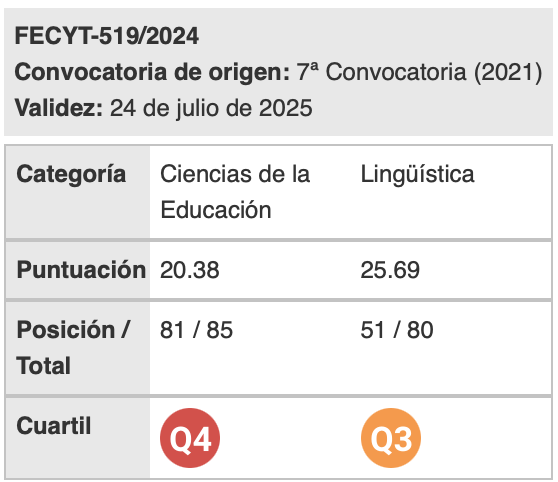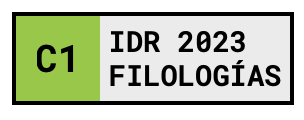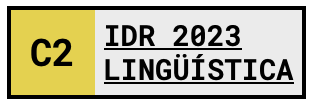A contribution of Natural Language Processing to the study of semantic memory loss in patients with Alzheimer’s disease
Keywords:
Natural Language Processing, FunGramKB, Semantic memory loss, Alzheimer’s dis-easeAbstract
This paper addresses semantic memory loss from the perspective of Natural Language Processing. Dementia disorders and, in particular, Alzheimer’s disease (AD) present a loss of cognitive functions, being one of them semantic memory impairment. We set from a study conducted by Grasso, Díaz & Peraita (2011) where they analysed the production of features of four semantic categories (2 Living Beings and 2 Non Living Beings) of healthy subjects and patients with different levels of Alzheimer’s disease, taken from the Linguistic corpus of semantic categories definitions elaborated by Peraita & Grasso (2010). The aim of this work is to enhance the protocol of semantic features employed in that study by using Natural Language Processing systems such as FunGramKB (Periñán-Pascual & Arcas Túnez 2004, 2005, 2006, 2007, 2010). This lexical-conceptual knowledge base incorporates a series of feature descriptors for the definition of semantic knowledge which, together with the inheritance and inference relations established among concepts in the ontology, will enrich the collection of semantic features used in the test of semantic attributes production for the detection of semantic memory impairment (Grasso, Díaz & Peraita, 2011).Downloads
References
Atkinson, R.C. & Shiffrin, R.M. (1968). Human memory: A proposed system and its control processes. In K. W. Spence & J. T. Spence (Eds.) The psychology of learning and motivation (Vol 2). (pp. 89-165). London: Academic Press.
Atkinson, R.C., & Shiffrin, R.M. (1971). The control processes of short-term memory. Institute for Mathematical Studies in the Social Sciences. Stanford University.
Grasso, L., Díaz, M.C. & Peraita, H. (2011). Deterioro de la memoria semántico-conceptual en pacientes con enfermedad de Alzheimer. Análisis cualitativo y cuantitativo de los rasgos semánticos producidos en una tarea verbal de definición categorial. Psicogeriatría 3(4), 159-165.
Guerrero, J.M., Martínez-Tomás, R., Rincón, M. & Peraita, H. (2015). Diagnosis of cognitive impairment compatible with an early diagnosis of Alzheimer’s disease. A Bayesian network model based on the analysis of oral definitions of semantic categories. Methods Inf Med 1, 42-49.
Jiménez Briones, R., Luzondo Oyón, A. & Pérez Cabello de Alba, M.B. (2011). FunGramKB y la organización ontológica. Anglogermánica Online 8, 16-36.
Mairal Usón, R. (2012). La arquitectura de una base de conocimiento léxico conceptual: implicaciones lingüísticas. In M. Giammatteo, L. Ferrari & H. Albano (Eds.), Léxico y sintaxis.: Volumen temático de la serie editada por la Sociedad Argentina de Lingüística (183-210). UNCuyo: Editorial FFyL.
Mairal Usón, R. & Periñán-Pascual, C. (2009). The anatomy of the lexicon within the framework of an NLP knowledge base. Revista Española de Linguística Aplicada 22, 217-244.
McLeod, S. A. (2007). Multi store model of memory - Atkinson & Shiffrin, 1968. <http://www.simplypsychology.org/multi-store.html> [19/02/2017]
Miller, G. (1956). The magical number seven, plus or minus two: Some limits on our capacity for processing information. Psychological Review 101(2), 343-352.
Moreno-Martínez, F.J. & Rodríguez-Rojo, I.C. (2015). The Nombela* 2.0 semantic battery: An updated Spanish instrument for the study of semantic processing. Neurocase, 21(6),773-85.
Peraita, H., Díaz, C. & Anllo-Vento, L. (2008). Processing of semantic relations in normal aging and Alzheimer’s disease. Archives of Clinical Neuropsychology. 23(1), 33-46.
Peraita, H., Elosúa, R. & Linares, P. (1992). Representación de categorías naturales en niños ciegos de nacimiento. Madrid:Trotta.
Peraita H., González-Labra M.J., Sánchez-Bernardos M.L. & Galeote M.A. (2000). Batería de evaluación del deterioro de la memoria semántica en Alzheimer. Psicothema 12, 192-200.
Peraita, H. & Grasso, L. (2010). Corpus lingüístico de definiciones de categorías semánticas de personas mayores sanas y con la enfermedad de Alzheimer. Una investigación transcultural hispano-argentina. Documento de trabajo BBVA. (Documentos de Trabajo 3, 2010) < http://www2.uned.es/investigacion-corpuslinguistico/> [19/02/2017].
Periñán-Pascual, C. & Arcas Túnez, F. (2004). Meaning postulates in a lexico-conceptual knowledge base. 15th International Workshop on Databases and Expert Systems Applications, Los Alamitos (California). IEEE, 38-42.
Periñán-Pascual, C. & Arcas Túnez, F. (2005). Microconceptual-knowledge spreading in FunGramKB. In Proceedings on the 9th IASTED International Conference on Artificial Intelligence and Soft Computing (pp. 239-244) Anaheim-Calgary-Zurich: ACTA Press.
Periñán-Pascual, C. & Arcas Túnez, F. (2006). Reusing computer-oriented lexica as foreign-language electronic dictionaries. Anglogermánica Online 4, 69-93.
Periñán-Pascual, C. & Arcas Túnez, F. (2007). Cognitive modules of an NLP knowledge base for language understanding. Procesamiento del Lenguaje Natural 39, 197-204.
Periñán-Pascual, C. & Arcas Túnez, F. (2010). Ontological commitments in FunGramKB. Procesamiento del Lenguaje Natural 44, 27-34.
Periñán-Pascual, C. & Arcas Túnez, F. (2011). Introducción a FunGramKB. Anglogermánica Online, 8, 1-15.
Pustejovsky, J. (1991). The generative lexicon. Computational Linguistics, 17(4), 47-81.
Pustejovsky, J. (1995). The generative lexicon. Cambridge, MA: MIT Press.
Raaijmakers, J.G.W. & Shiffrin, R.M. (2003). Models versus descriptions: Real differences and language differences. Behavioral and Brain Sciences 26, 753.
Rodríguez, R.J. (2010). Herramientas informáticas para la representación del conocimiento. Software tools for knowledge representation. Subjetividad y Procesos Cognitivos 14(2), 217-232.
Rodríguez-Rojo, I.C., Lugo-Marín, J. & Moreno-Martínez, F.J. (2015). Category specificity, Alzheimer disease and normative studies: A review and several recent instruments for Spanish speakers. Austin Journal of Clinical Neurology 2(7), 1058.
Tulving, E. (1972). Episodic and semantic memory. In E. Tulving & W. Donaldson (Eds.), Organization of memory (pp. 381–402). New York: Academic Press.
Vivas, J., et al. (2014). Organización reticular de la memoria semántica. Natural Finder y Definition Finder, dos métodos informatizados para recuperar conocimiento. Encontros Bibli: Revista letrônica de biblioteconomia e ciência da informação, 19(40), 235-252.
Downloads
Published
How to Cite
Issue
Section
License
Authors who publish with this journal agree to the following terms:
- Authors retain copyright and grant the journal right of first publication with the work simultaneously licensed under a Creative Commons Attribution License that allows others to share the work with an acknowledgement of the work's authorship and initial publication in this journal.
- Authors are able to enter into separate, additional contractual arrangements for the non-exclusive distribution of the journal's published version of the work (e.g., post it to an institutional repository or publish it in a book), with an acknowledgement of its initial publication in this journal.
- Authors are permitted and encouraged to post their work online (e.g., in institutional repositories or on their website) prior to and during the submission process, as it can lead to productive exchanges, as well as earlier and greater citation of published work (See The Effect of Open Access).

Revista de Lenguas para fines específicos is licensed under a Creative Commons Reconocimiento-NoComercial-SinObraDerivada 4.0 Internacional License.
























